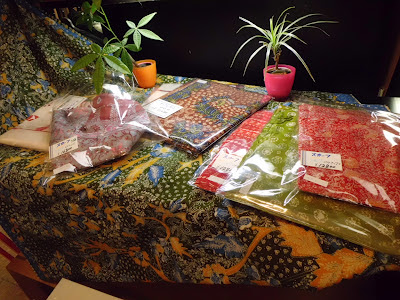One of the interesting things about living overseas is that you start to value things that you take for granted in your home country.
海外で暮らすことの面白い点の一つは、自分の国で当たり前だと思っていた物事の価値を、改めて見直すことです。
Take an example: food. It's common when you are in your home country, you don't finish your meal (for being too full perhaps) and you just throw it away without feeling guilty (or just a little bit of it). There's plenty of this food in the country so we often don't think much before throwing it away. But when you're in a foreign country, this particular food is immensely valued for its rarity. You look for it, search, hunt..You pay a great amount of money for just a tiny amount of this food. Then you start to realize how valuable this food is..
例えば、食べ物。自分の国に住んでいれば、お腹がいっぱいになったなどの理由で食べ物を残したり、あるいは捨てたりすることに対して、申し訳ない、と感じたりすることは、あまりないかも知れません(あるいはあったとしても、ほんの少しだったりします)。自分の国にはこの食べ物はたくさんあるのだから、と、それを省みることは、あまりなかったりします。でも、もし外国に住んでいれば、この食べ物は、とても貴重になります。なぜならそれは、めったに見られない食べ物に変貌するからです。このちっぽけな食べ物を手に入れるのに、たくさんお金を払わなければならないかも知れません。そのとき初めて、この食べ物が貴重なものであったと、知ることになるのです。
In my case, it is
TEMPE or
TEMPEH.
私の場合、それはテンペでした。
This molded soy bean foodstuff is served almost daily at the dining table of almost every household in Indonesia. It's kind of like misoshiru to Japanese. We, Indonesian, eat tempe everyday. It's cooked in 1001 ways. Fried, steamed, stir-fried. Served it as part of daily meals or as snack.
この発酵豆食品であるテンペは、インドネシアではほとんど毎日のように、食卓に上るものです。日本の味噌汁みたいなものですね。私たちインドネシア人は、テンペを毎日食べます。1001通りもの調理の仕方があります。揚げたり、蒸したり、混ぜ合わせてからフライにしたり・・・。三度の食事の他に、おやつとしても食べられます。
In Indonesia, it doesn't cost much to buy tempe. Here, in Japan it costs me
over several hundreds yen to get about 300 gr of tempe. It's like 10 times!!! Given the price, I treasure tempe like I never did before.
インドネシアでは、テンペはそんなに高くありません。でもここ日本では、300グラムのテンペを手に入れるのに、数百円以上かかったりします。約10倍です!こうしてテンペは、今の私にとって、宝物になってしまったのです。
I made the best of my visit to Tokyo last month by shopping at Toko Indonesia Okubo. It's a shop selling Indonesia's foodstuff and other South East Asian's. It's located near Okubo station, Tokyo. I bought 3 chunks of tempe. I was so happy!! It's like finding a treasure!
幸運にも先月、私は上京して、大久保にある『トコ・インドネシア』で買い物をしました。そこでは、インドネシアやその他の東南アジアの食材を、簡単に手に入れることができます。東京の大久保駅のすぐ近くですね。私はテンペを、3パック買いました。嬉しい!それは宝物を見つけたようなものでした。
How do I cook tempe?
さて、どうやってテンペを料理しようか?
This is the simplest way of cooking tempe: deep-frying it.
最も簡単なテンペの料理の仕方、それは、フライです。
I'm going to share this simple recipe. Easy and delicious!
それでは、レシピをご紹介しましょう。簡単でおいしいですよ!
Ingredients:
About 300 gr of tempe
1 clove of garlic ground
a teaspoon of coriander seeds
salt
water
<材料>
300グラムのテンペ
にんにく一片
コリアンダー小さじ一杯
塩
水
First peel the garlic, chopped and grind it using stone grinder if you have it. since I don't have a stone grinder either, I use goma suri. It looks like this.
まずにんにくの皮をむき、それを千切りにして、もしあれば石臼で挽きます。うちには石臼がないので、胡麻すりを使います。こんな感じです。
 |
Garlic, coriander seeds and salt are ground into paste.
にんにく、コリアンダー、塩をペースト状にします |
Then add some water.
次に水を加えます。
 |
It will look like this.
こんな感じ。 |
|
|
Now take the tempe.
さあ、テンペの出番です。
 |
The spongy cottony tempe. This is about 300 gr.
スポンジみたいにやわらかいテンペ。これで300グラム程度です。 |
|
Slice the tempe thinly about 3 mm or as you like.
テンペを厚さ3ミリ程度に、あるいはお好みに合わせてスライスします。
 |
As you cut it, the tempe reveals its soy beans.
テンペを切ると、大豆が現れます。 |
|
After that marinate the slices of tempe in the mixture. And leave them for about 15 - 30 minutes depending how you like it. I like it with strong saltiness and coriander flavor. So I usually soak them for 30 minutes.
そしてそれを、マリネに漬けます。15分から30分、それもお好みです。私は少々塩味でコリアンダーの風味が効いている方が好みなので、大抵30分くらい漬けます。
 |
Marinated.
漬けるとこんな感じ。 | |
Then what is left is frying it. Deep fry it until golden brown.
後はそれを、フライにするだけです。黄金色になるまで、しっかりフライします。
Prepare some oil paper sheets to absorb the oil. Put the fried tempe on the sheets.
油を吸収するペーパーを、あらかじめ用意しておいて下さい。そのシートに、テンペをのせます。
And finally the simplest fried tempe is ready. Served with piping hot rice. Yummmm!! Bon apetit! Itadakimasu! Selamat makan! :-)
ついにテンペ・フライの出来上がりです。熱いご飯と一緒に召し上がれ。うーん、おいしい!いただきます!
 |
The simplest way to enjoy tempe ^o^
テンペ楽しむ簡単なやり方! |






























